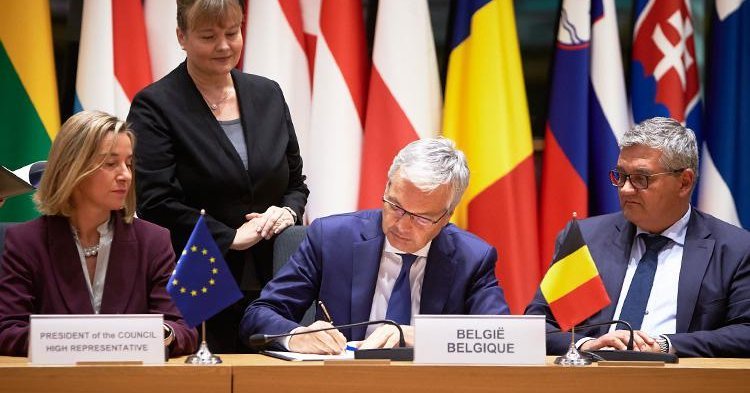PESCO is a treaty-based framework initially outlined in Article 42 (6) of the Lisbon Treaty according to which those “member States whose military capabilities fulfil higher criteria and which have made more binding commitments to one another in this area with a “view to the most demanding missions” shall establish permanent structured cooperation” in the field of Common Security and Defence Policy (CSDP).
The main aims of the framework are represented by a triple helix in the form of enhancing the operation readiness of EU Member States armed forces, increase investment in defense and cooperate in developing defense capabilities.
The signing of the PESCO official letter marked the second step in the establishment of the framework, the first one being represented by the list of common commitments presented by Member States two months earlier. By the end of the year, a qualified majority within the European Council should make PESCO legally binding by signing the final agreement as a third step.
Why has President Juncker’s ‘Sleeping Beauty’ finally awoken from its 6-year nap? The shakedown felt with the shifting of the tectonic plates within the geopolitical landscape between 2014 and up to the present day reinforced the idea that Europe is obliged to harmonize its defense capabilities for the sake of its territorial and virtual security. And as if that was not a bona fide reason in itself, the political landscape was revamped as well with the result of the 2016 presidential elections across the Atlantic which again raised the possibility that NATO might not always be there for Europe.
Parenthetically, there is a practical reasoning escorting the idea of PESCO to the negotiating table: money. Governments never have enough of it. How could certain Eastern European administrations justify to the public the need to spend 2% from the GDP on defense when the welfare system is not equipped nearly enough and salaries are not up to par? They couldn’t. They can’t. And now they might not have to.
Creating a shared financial and military honeypot could significantly reduce national spending on defense, according to the latest studies conducted by the European Parliamentary Research Service. This means that as long as countries feel like their security goals can be accomplished without having to spend the 2%, they might go for PESCO in the detriment of NATO.
Which leads us to the bad news…
Regardless of the fact that high-level voices from both EU and NATO have stated time and time again that PESCO has ‘not set such a goal’ as to compete against NATO, it is highly likely that it will do just that. The funds EU countries are willing to allocate to defense spending are limited, which makes prioritization between purchasing different types of defense equipment problematic.
What the EU deems as ‘urgently needed’ overlaps only to a certain extent with what NATO expects. Maybe in areas such as cybersecurity investment, air-to-ground surveillance airplanes and transport airplanes and ships, the EU and NATO can agree to invest. But in areas meant to tackle hard security issues, NATO’s priorities are quite different from the ones set forth by the EU. For instance, the buying of missile defense, heavy armour, air command systems and anti-submarine warfare, just to name a few, rarely make it on the CSDP agenda, if ever.
Too Inclusive, Too Modular
By the same token, from the European Defense Agency side, PESCO is seen as too inclusive – including even the initially more reluctant nations – which makes it impossible for all participating countries to be on the same wavelength in order to make a long-lasting contribution to European and foreign security. While the EU Global Strategy on Foreign and Security Policy (EUGS), adopted in the summer of 2016, could serve as the guiding force behind the strategic decisions and, hence, prioritization of problematic geographical areas for Europe, this is clearly not the case since the strategical document is non-binding.
What is more, different members have different concerns spread all across the spectrum. South-East Europe is uneasy regarding the Middle East, South-West Europe is worried about North Africa and from the Baltic states the threat of Russia reverberates all throughout. It doesn’t take a fortune teller to anticipate at least the potential of a cumbersome multilateral paralysis engulfing PESCO even before it gets to decide on its first 10 projects.
Why too modular? It seems that not all PESCO members need to participate in all projects, (a move away from the political as some might argue), which is at the heart of what makes PESCO break completely new ground. What this means is that even though 23 EU countries signed on, at no point in time are ALL of them under the obligation to participate in EVERY joint acquisition and operation.
Instead, countries put forward their project in much smaller units and take it one day at a time, one project at a time. Is that the perfect breeding ground for trouble? Not if representatives take joy in the rising difficulty of convincing other states to agree on their preferred operations, which might not spark the same interest in all players.
An Instrument and a Stimulus
Indeed, it takes a village of imaginative security analysts and policymakers to acknowledge the opportunities that this (potentially) soon-to-be pan-European military bestows upon the European continent. While it seems entirely in the realm of the possible that the decisional muscle within PESCO might become strained at times due to diverging geopolitical interests and it might clash with NATO regarding prioritization of defense apparatus purchasing, the mere fact that PESCO is a ‘milestone in European development’ cannot be disregarded.
The Sleeping Beauty of European defense is that quintessential instrument which complements the horizontal alignment of national defence planning starting from the strategic level and moving downwards with the bottom-up and one-project-at-a-time feature. It is the stimulus that aims to showcase Member States the benefits of using existing institutions, such as the European Defense Agency, by having all 23 signatories work within this cooperative instrument.


Follow the comments: |
|
